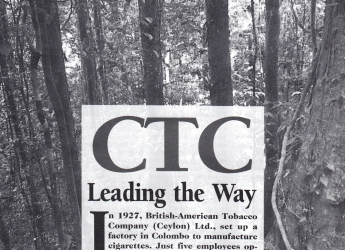
Thai Airways International Ltd., celebrate on November 3rd, twenty years of its operational service to Sri Lanka.
The airline which has an aviation history of 36 years, and is popularly referred to as ‘more than just an airline’ has since its first aircraft the Douglas DC-6B take-off on May 1,1960, from Bangkok’s Don Muang Airport to Hong Kong-developed to the extent that it now enjoys the reputation of being “one of Asia’s fastest growing and most profitable airlines” having, of course, recorded “profits for 31 consecutive years and increased its modern aircraft fleet to 73,”
“Our airline made a profit for the first time in 1964 and since then has not reported a loss. Our modern aircraft includes the world’s first Boeing 777 with Rolls-Royce Trent 800 engines-the first Boeing for Thai”, said Siriphong Mangkalee, General Manager, Thai Airways International Public Co., Ltd.
Thai’s latest financial year report reflects a profit of USS 2.9 billion – an increase of 11.7% over the previous year and the number of passengers carried as being 12,833,539.
Today, its modern fleet of air- crafts fly to 72 destinations in 37 countries across four continents Asia, Europe, America and Australia.
As far as Sri Lanka is concerned, Thai began its flight services on November 3rd, 1976 with its DC 8 and one-weekly flight between Bangkok and Sri Lanka.
By 1977, it had increased its frequency to two flights per week. In mid-June 1976, the DC 8 was replaced by the A300 and Thai thus had the privilege of being the first Asian Airline to fly this air-craft. During the years December 1979 to 1980, the flights were increased to 3 per week and the years 1993 to 1995 saw changes in flight schedules and the McDonald Douglas MD II replaced the A300.
During the last 20 years, Thai has been of assistance to Sri Lanka in a number of ways. It has helped freight forwarders by providing cargo space to Bangkok and its growing network. It has featured Sri Lanka in its Royal Orchid Holidays program-thus benefiting our tourism industry with “Advertising and Promotion” via Thai offices worldwide.
Thai has also with its Royal Orchid Plus frequent flyer program introduced in July 1993, been offering a number of travel privileges to “our 1,300 members such as free travel, based on the mile- age covered, irrespective of the class of travel-first, business or
economy.”
Thai Airways has its own strategy for shaping its future and stabilizing its position as a global airline with a strong presence within the Asian region.
“And why should we not?”, asks Mangkalee. “When international travel is growing at an unprecedented pace affording a wealth of opportunities for an increasing global economy.”
Having realized that to fly to all corners of the globe with its own aircraft to achieve that “International reach” is not feasible, Thai has entered into “strategic alliances” with other Airlines like Germany’s Lufthansa (which will carve out its position as South East Asia’s Aviation hub) and America’s United Airlines.
Under these partnerships, the flight schedules of these three airlines are coordinated, passenger services facilitated and code sharing arrangements are arrived at, which enable them to offer seats on another partner carrier. In this way, Thai is able to extend its Route services to the Far East, Europe and the USA, which would otherwise not have been commercially viable.
With these “Strategic alliances” and a base in Bangkok (and in Europe through Lufthansa), Thai Airways expects to build an “aviation super highway.”
There is also one thing that Thai Airways heavily concentrates on and that is providing its passengers with flight safety. Thus we look critically when recruiting pilots and at our pilot training procedures. Pilot training being a must, the quality of training given to our pilots leave no room for compromise. Because we’re committed to maintaining the maximum standards of flight safety, we seek and rely on advance technologies, said Mangkalee.
He says that Thai Airways has maintained an uninterrupted flight service to Sri Lanka whatever the conditions and that they hope to continue and maintain their strong presence in this market in the years ahead too.



